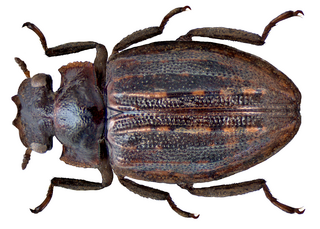
Spercheus is a genus of aquatic beetles which are placed in a family of their own, Spercheidae. About 20 species are known from around the world, with the majority being from the Oriental and Afrotropical Realms.

A water beetle is a generalized name for any beetle that is adapted to living in water at any point in its life cycle. Most water beetles can only live in fresh water, with a few marine species that live in the intertidal zone or littoral zone. There are approximately 2000 species of true water beetles native to lands throughout the world.

Hydrophilidae, also known colloquially as water scavenger beetles, is a family of chiefly aquatic beetles. Aquatic hydrophilids are notable for their long maxillary palps, which are longer than their antennae. Several of the former subfamilies of Hydrophilidae have recently been removed and elevated to family rank; Epimetopidae, Georissidae, Helophoridae, Hydrochidae, and Spercheidae.
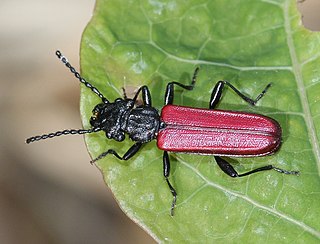
The Cucujidae, "flat bark beetles," are a family of distinctively flat beetles found worldwide under the bark of dead trees. The family has received considerable taxonomic attention in recent years and now consists of 70 species distributed in five genera. It was indicated Cucujus species are scavengers, only feeding on pupae and larvae of other insects and on other subcortical beetles such as their own. Since the Cucujidae prey on larvae of potentially tree damaging beetles that spread fungal diseases, they are considered to be beneficial to the health of living trees.
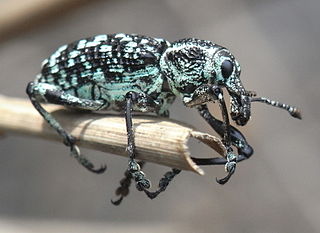
Chrysolopus spectabilis is a species of weevil found in south-eastern Australia. It was discovered during James Cook's first voyage, and became one of the first insects to be described from Australia. The weevil measures up to 25 mm (1.0 in) long and includes distinctive metallic green and black scales. It is found only on 28 species of the plant genus Acacia.

The Donaciinae are a subfamily of the leaf beetles, or Chrysomelidae, characterised by distinctly long antennae. They are found in mainly the Northern Hemisphere, with some species found in the Southern Hemisphere.
Hygrobia is a genus of aquatic beetles native to Europe, North Africa, China and Australia. It is the only genus in the family Hygrobiidae, also known as the Paelobiidae. These are known commonly as squeak beetles or screech-beetles.
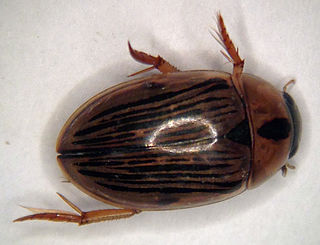
Tropisternus is a genus of hydrophilid beetles with 63 species in five subgenera in North and South America.
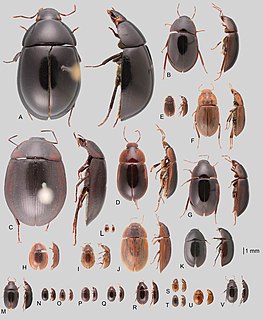
Acidocerinae is a subfamily in the family Hydrophilidae of aquatic beetles, and it contains over 500 species in 23 genera.

Sphaeridium is a genus of beetles in the family Hydrophilidae, the water scavenger beetles. They occur in Europe, and some species have been introduced to North America.

Sphaeridiinae is a subfamily of water scavenger beetles. Some species live in fresh water as both larvae and adults.
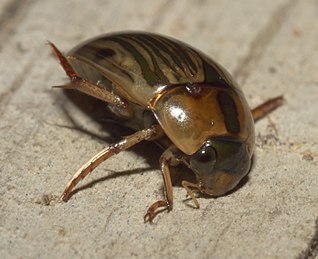
Tropisternus collaris, the collared water scavenger beetle, is a species of water scavenger beetle in the family Hydrophilidae. It is found in the Caribbean, North America, and South America.

Cercyon is a genus of water scavenger beetles in the family Hydrophilidae. There are at least 50 described species in Cercyon.
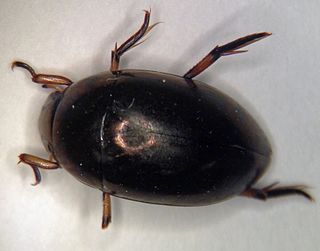
Tropisternus blatchleyi is a species of water scavenger beetle in the family Hydrophilidae. It is found in North America.

Euphoria fulgida, the emerald euphoria, is a species of scarab beetle in the family Scarabaeidae. It is found in North America.
Hydrophilus ensifer is a species of water scavenger beetle in the family Hydrophilidae found in the Americas. As of 2020, there are two valid subspecies of H. ensifer, H. e. ensifer and H. e. duvali, however the differences among the subspecies are not well understood.

Enochrus (Methydrus) esuriens, is a species of water scavenger beetle found in Indochina, Korea, China, Japan, Bhutan, Iran, Iraq, Nepal, India, Pakistan, Philippines, Sri Lanka, Vietnam, Sunda Island, Saudi Arabia and Australia.
Regimbartia attenuata, commonly known as Japanese water scavenger beetle, is a species of water scavenger beetle widely distributed in the Old World, from northern Australia and Japan westward to the countries of Arabian Peninsula, including Oman and Yemen. It is the only species of the genus occurring in the Arabian Peninsula.
Hydaticus vittatus, is a species of predaceous diving beetle found in India, Pakistan, Sri Lanka, Nepal, Bangladesh, Bhutan, Myanmar, China, Japan, Taiwan, Thailand, Cambodia, Laos, Vietnam, Malaysia and Indonesia.

Cybister tripunctatus, is a species of predaceous diving beetle found in India, Andaman & Nicobar Islands, Sri Lanka, Afghanistan, Bangladesh, Myanmar, Nepal, Pakistan, Bhutan, China, Cyprus, Iran, Iraq, Japan, Kyrgyzstan, Mongolia, Russia, Syria, Tajikistan, Turkmenistan, Italy, Turkey, Uzbekistan and Europe.


















